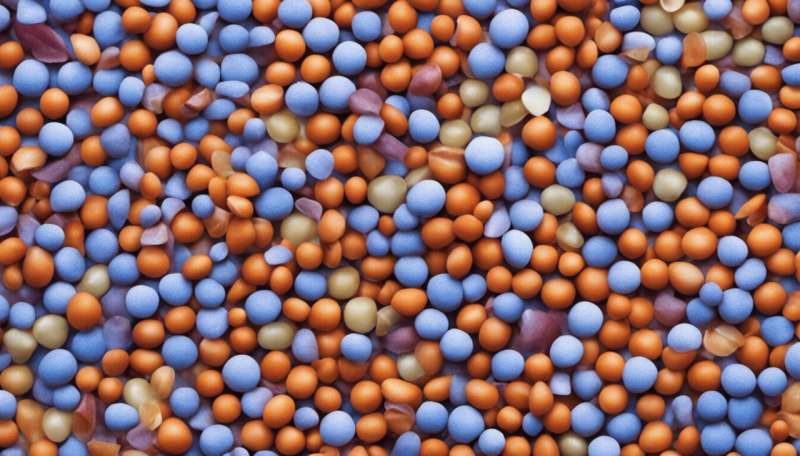Why some plastic packaging is necessary to prevent food waste and protect the environment

There has been a surge in awareness of the damage that plastic pollution does to our planet in recent years. It has spurred a number of campaigns to remove single-use plastics from our daily lives. This extends to food packaging, with a Waitrose supermarket in the city of Oxford recently .
Many people bemoan the large amount of packaging that supermarkets use, particularly for fruit and vegetables, most of which have their own natural protection. Nonetheless, a major reason that supermarkets use so much packaging is to protect food and prevent waste—particularly with fresh food. Removing plastic entirely from our food supply may not be the best solution when it comes to protecting the environment and conserving valuable resources.
Food supply chains are complex networks with lots of parts. In , 12m farms produce agricultural products which are processed by around 300,000 food and drink companies. These are then distributed by 2.8m food retailers and food services, serving around 500m consumers.
Food from the fields where it is produced to a storage facility for processing. It is then stored until it is needed. Then it's packaged, transported and distributed to shops, where it is marketed, before being bought and consumed. This takes a varying amount of time, depending on where it is farmed and how long it stays in someone's fridge or cupboard.
Plastic packaging is used in the food supply chain because it supports the safe distribution of food over long distances and minimises food waste by keeping food fresh for longer. A found that 88m tonnes of food is wasted every year in the EU—that's 173kg per person and equals about 20% of food produced. Minimising this wastage is crucial for environmental protection, as well as food security.
Reducing waste
More than 50% of food waste takes place in households and nearly 20% is wasted during processing. Plastic packaging may be a necessary evil to reduce this high level of waste in both areas. A number of factors must be taken into account when determining how useful plastic packaging is in the food supply chain, as it has the potential to preserve food and prevent its wastage.
For example, the use of just 1.5g of plastic film for wrapping a cucumber can extend its shelf life from three days to 14 days and selling grapes in plastic bags or trays .
A lot of food is air freighted, so prolonging its shelf life has important benefits for the environment. It minimises waste and conserves all valuable resources involved from farm to shelf. Recent estimates from Zero Waste Scotland suggest that the carbon footprint of food waste generated . Specifically, 456,000 tonnes of food waste produced in Scottish households were found to contribute to around 1.9m tonnes of COâ‚‚, three times higher than that of the 224,000 tonnes of plastic waste generated.
Plastic packaging maintains food quality and safety. Food that is naturally wrapped in its own skin and can be safely transported and consumed often draws attention. But research shows that these products appear to be sustainable . When food is transported from further away, , plastic can play an important role in protecting it from becoming waste.
Furthermore, plastic packaging is more flexible and lighter than alternatives such as glass and card. This and the carbon emissions that come with them.
Possible solutions
Simply removing plastic from food packaging is not as sustainable as one might think. There are lots of cases where plastic packaging can be beneficial at reducing waste. But food sellers need to think of ways to reduce and reuse the plastic where possible.
To reduce the amount of plastic that is needed, short food supply chains must be developed, as this involves very few intermediaries between where the food is farmed and where it is bought and consumed. It may mean switching to more seasonal diets. Farmers' markets, community-based growers and basket delivery systems helps connect consumers to where their food is produced in ways that can also help reduce food packaging and waste.
The challenge here is how it can be scaled up in ways that are economically feasible. Most sellers will have economic concerns that influence how they use plastic. It is often not just used for preservation but for marketing and the desire of retails to get people to buy more (think multipacks), which can lead to waste.
Another solution is to develop a more circular economic model where plastic is reused and recycled a lot more. This makes economic as well as environmental sense.
Work is also being done into new, that can perform the same role as conventional plastic in terms of protecting food and preventing food waste—and could also be biodegradable. But a lot of questions remain as to whether bio-based plastics are actually sustainable in the long term, especially if vast amounts of resources are needed to produce them.
Until a sustainable packaging alternative is developed, big retailers will continue to rely on plastic to protect food from going to waste. Plastic itself is a very useful material. We need to use it more effectively and more sparingly in some cases but we shouldn't get rid of it altogether.
Provided by The Conversation
This article is republished from under a Creative Commons license. Read the .![]()



















